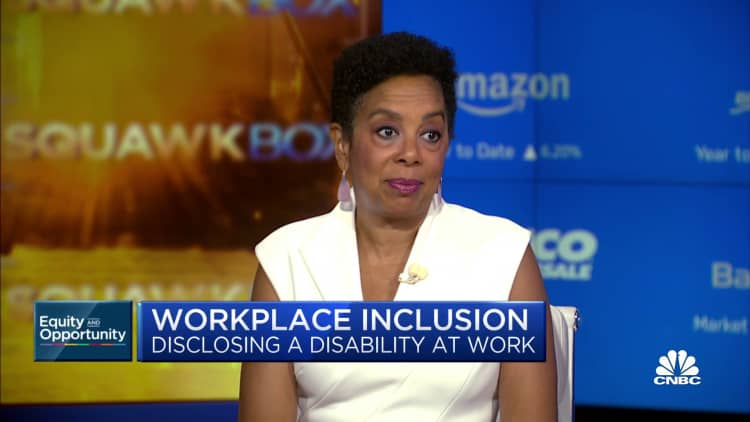
Getting a foot in the door of a company is often a major hurdle for people with disabilities looking for employment, even 33 years after the passage of the Americans with Disabilities Act. The ADA is a federal law requiring employers to make “reasonable accommodations” — adjustments or modifications — for qualified job applicants or employees with a “known disability.”
“A lot of hiring managers typically like to hire people that are similar to them,” noted Rob Koch, who is deaf and now works as a principal in data engineering at Seattle-based tech firm Slalom Build. “So that’s the challenge that we have to overcome.”
How companies can create ‘a culture of inclusion’
Rob Koch speaks to CNBC on Zoom with ASL interpreter, Amelia Fruehsamer.
When a recruiter for Slalom Build asked Koch the type of accommodations he would need to be “successful” in interviews, he requested a sign language interpreter and closed captions for virtual conversations on Zoom and Microsoft Teams. The company provided those supports. After several rounds of interviews, he was hired.
“I am currently moving up the ranks,” Koch said through an interpreter. “But in the corporate world, there’s not a whole lot of deaf and hard-of-hearing people.”
Yet, employees with disabilities make up a sizeable share of the global workforce, by some estimates.
Some 25% of people say they have a disability or health condition that limits a major life activity, according to a recent survey from consulting firm Boston Consulting Group, which polled nearly 28,000 employees in 16 countries. In a July 2023 report by the nonprofit Disability:IN, fewer than 5% of U.S. employees voluntarily reported that they have a disability, although the vast majority of their employers (93%) encouraged them to self-identify.
More from Personal Finance
Less than 5% of housing accessible to older, disabled Americans
Take these 3 actions now to start cleaning your financial house
Hybrid work is the new normal, as companies rethink work habits
“Even though workplaces can focus on creating a culture of inclusion, there’s that internal barrier that people still struggle with, because the world is telling them that disability is shameful, that disability is wrong, that their existence is somehow a mistake,” said Emily Ladau, a disability rights advocate and author of “Demystifying Disability: What to Know, What to Say, and How to be an Ally.”
“And that is really, really difficult to overcome that narrative,” she added.
Overcoming barriers to inclusion
Some employers — like PSEG, an energy company based in Newark, New Jersey — have launched initiatives to encourage people with disabilities to bring their full selves to work.
PSEG held a yearlong campaign to try to build empathy and destigmatize what it means to have a disability. The company had employee leaders talk about their experience living with a disability or caring for someone with a disability, sent around education materials and brought in outside speakers. The aim was to bring understanding and make employees comfortable talking about disabilities.
“We’d be excluding a huge pool of potential employees if we weren’t focused on that population, and not just bringing them in the door, but making sure they had the resources and the comfort that they need to feel included and want to stay,” said Steven Fleischer, a human resources executive who leads diversity, equity and inclusion at PSEG.
After its awareness campaign, PSEG found the percentage of people who identified as disabled in its workplace tripled.
“I think there’s a fear and a stigma that, if I raise my hand, I’m going to be perceived as weak or unable to take on a bigger role or a bigger assignment,” said Fleischer, who helped lead the campaign. “So the work that we did, I think, helped to create that safety and have people feel comfortable raising their hands and saying ‘I’m disabled.'”
Creating opportunities to connect
Research has shown that leaning on employees with disabilities to educate and connect with co-workers can help increase the numbers of people who disclose a disability and request accommodations. Having a senior executive who has a disability or is an ally and giving voice to mid-level leaders with disabilities, as well, can help bring more employees into the fold.
Still, employees with disabilities may stay silent — fearing stigma or losing out on a job or promotion. But Ladau says that can change.
“When we shift that narrative and we begin to say, ‘You can identify as having a disability. That is something that you can be proud of. That makes you who you are,’ the number of people who identify in the workplace as disabled is going to grow,” she said.
Koch is also part of a new working group within the Cloud Native Computing Foundation that seeks to encourage more deaf and hard-of-hearing individuals to participate in open source efforts and become more visible within the community. The group is working on inclusiveness recommendations for open source projects and conferences and to provide support and networking opportunities for its members.
“As far as the corporations go, once you’re in the rest is history, really,” said Koch.

